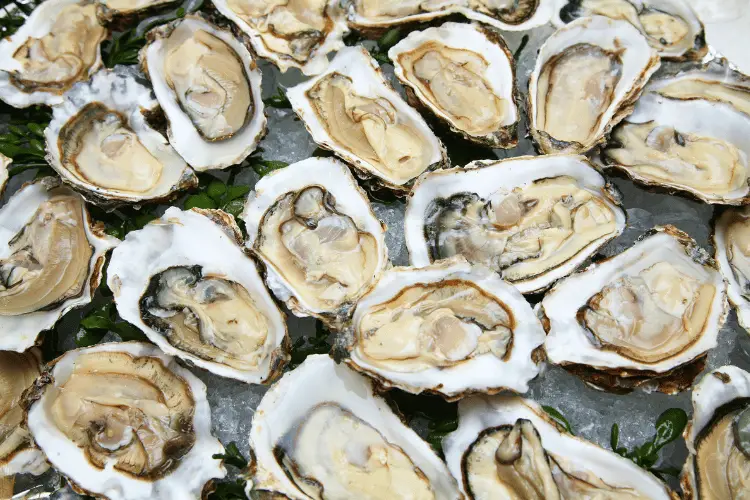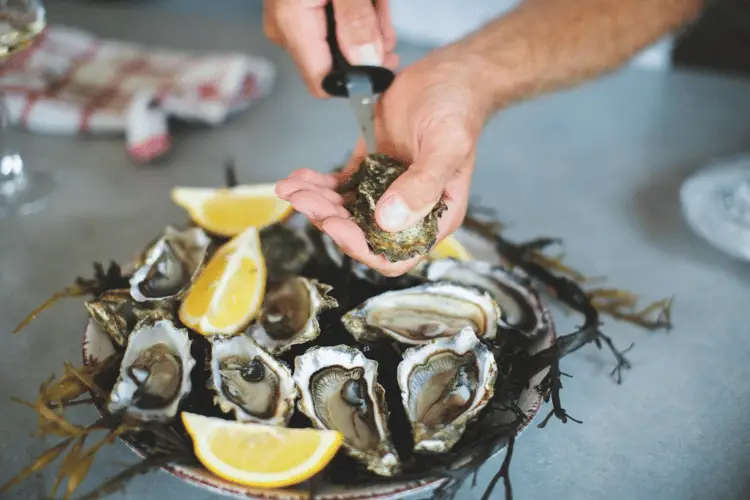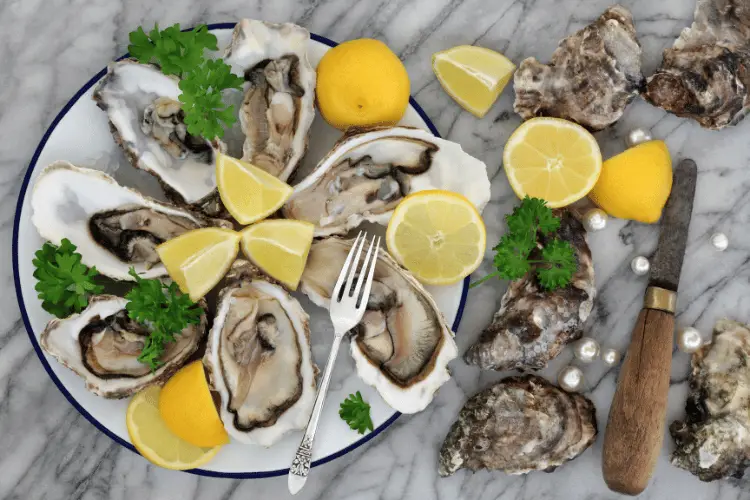We strive to provide you with authoritative, trustworthy, and expert advice. In doing so, the staff at texaswalkabout.com performs extensive research, editing, and fact checking to every post on this webiste. If you feel that this article can improve, please feel free to reach us at staff@texaswalkabout.com
Texas cuisine is among the richest in the US, with influences from Tejano, Native American, Mexican, Cajun, African American, Creole, German, and even Czech cuisines.
But for many years, people have always been fascinated by Texas oysters, which can be found in the coastal waters of the Lone Star State.
So, what oysters are in Texas? Which months are the best for eating oysters in Texas? Do these oysters have pearls?
You’ve come to the right place because you’ll get the answers from a Texas native, so let’s dive in.
Are There Oysters in Texas?
Oysters can be found in several enclosed regions along the coasts of Texas, especially where the bottom is slightly hard.

They grow and multiply in these areas, providing an essential habitat for different marine organisms.
Oyster reefs are known to be home to about 300 species of aquatic organisms. These animals and plants are food sources for the local fish species.
Some marine creatures also use these reefs for shelter and hiding.
But finding single oysters along the coast is also possible.
Oysters have a high commercial value as people eat them. As a result, they’re harvested from public reefs and private oyster leases.
Most public reefs are found along San Antonio Bay and in Galveston Bay.
What Oysters Are in Texas?
The Eastern oyster is the most widely harvested oyster in Texas. It’s also known as the Virginia oyster, Atlantic oyster, American oyster, and Gulf Coast oyster.
This animal thrives in shallow saltwater bays, so it’s mainly found along the estuaries in the Gulf of Mexico.
It’s highly adaptable, which makes it survive in shallow waters, where the conditions can change drastically.
Eastern oysters prefer to settle up to 25 feet underwater, but they can also live in cages and baskets near the surface if they can access algae and phytoplankton to feed.
Oysters attach themselves to hard objects like rocks and piers, forming layers on top of one another to create oyster reefs. These oyster reefs attract other marine animals like sponges, crabs, and fish.
They can survive in temperatures between 28 and 90 degrees Fahrenheit, so they can be found at different times of the year along the coast of Texas. They also don’t mind different salinity degrees.
In less-than-ideal conditions, these oysters shut their shells firmly to be able to survive. They can also tolerate being out of the water for short periods.
About 80% of the oysters you can find and eat in Texas are harvested by oyster fishermen from Galveston Bay.
They refrigerate the oysters because freezing will kill them instantly, and they won’t taste as good.
Then. they’re transferred in trucks by plane to different parts of Texas. They’re also transferred to nearby states.

Closed oysters can live up to two weeks and still be fresh and tasty if the shell is kept moist.
Shucked oysters don’t last that long. They should be packed in jars with their thick juices and consumed fast before they go bad.
The U.S. Public Health Service and the Texas State Department of Health run periodic tests to guarantee people won’t have access to polluted oysters.
West Coast oysters are strictly farm-raised and are illegal to sell fresh on shell in Texas. However, they can be found in some restaurant menus.
What Months Are Oysters in Texas?
Eastern Oysters can be found in Texas most of the year, but they’re at their best from September to April. Some experts suggest that the best months to enjoy Oysters in Texas would be from November to April, specifically from January to March.
According to Texans, eating oysters in months that don’t have R in their names is not recommended.
You can find oysters in May, June, and July, but they will be watery and not as tasty. Yet, they’re not dangerous or poisonous.
What is Texas Oyster Season?
Galveston Bay oysters, which represent most of the oysters you can find in Texas, are their best from Christmas to Easter.
Anyone can harvest oysters from the first of November to the 30th of April. This is when recreational harvesters can also catch some fresh oysters.
Commercial leaseholders can harvest oysters all year long. Yet, it’s better to avoid harvesting them in the summer to encourage mating, so there can be a good harvest during the season.
You can enjoy the best-tasting oysters in Texas in January, February, and March. As a matter of fact, they’re among the most valuable and delicious oysters you can find in the US.
Does Texas Have Good Oysters?
Texas has good oysters, especially if you know where to get them. The best experience you can have is to order unshucked oysters and open them yourself, but you might get hurt if you’re not an expert.
Yet, this is an excellent way to guarantee that you’re enjoying fresh oysters.
If you order shucked oysters, you can visit the kitchen to see how they’re prepared. Most high-quality and reputable restaurants wouldn’t mind your visit.
Here are some of the top places to enjoy oysters in Texas.
Gaido’s
If you’re in the mood for fresh oysters, you should consider visiting Gaido’s. Founded in 1911, this seafood place has harvested and served the freshest oysters from Galveston Bay for over a century.
Most visitors enjoy raw and grilled oysters, while some prefer the shellfish tower, where they can enjoy oysters with shrimp and crabs.
Black Diamond Oyster Bar
If you like raw oysters, then visiting this place will be a must. One family has been running this establishment since 1968, following secret recipes to serve the best oysters and Texan food.
Raw and fried oysters are served in multiple ways, and people can enjoy the not-so-crowded setup to enjoy some quality time.
Liberty Kitchen & Oysterette
This is one of the best spots to enjoy the local American cuisine with some of the most delicious freshly served oysters.
Oyster lovers are in for a treat because you can find them served raw, fried, grilled, in salads, or stews.
People love to visit one of its two Houston locations in time for the happy hour. But even if you miss it, the oyster bar stays open.
Gilhooley’s Restaurant and Oyster Bar
Ranked as the second-best restaurant in San Leon, this is an excellent place to enjoy tasty oysters brought fresh from the coast.
This restaurant is located near a sourcing company, so you can guarantee that your oysters will always taste heavenly.
It’s an excellent spot to try fresh oysters that you can enjoy with some lemon and your favorite sauce. BBQ-grilled oysters are served with parmesan cheese if you don’t like eating the raw ones.
Deckhand Oyster Bar & Seafood
You can find this seafood eatery at two different locations in Austin. The first one was founded in 2010, bringing the concept of a laid-back dining experience with tasty and high-quality seafood that the whole family would enjoy.
After the success of the first location in North Austin, the restaurant opened a new spot in South Austin.
Oysters la fontera is one of the best plates to try, featuring boiled oysters with crab meat stuffing topped with cheese. Fried oysters are also available.
What Happened to Texas Oysters?
Texas oysters took several hits that affected their harvest and consumption.
The 2008 Hurricane Ike hit the Lone Star State hard and damaged various areas. It also destroyed 6,000 acres of oyster reefs in Galveston Bay.
Oysters were able to make a comeback, and harvesters were back in business until tragedy struck for the second time.
In 2014, the years-long drought affected the oyster supply in the Gulf Area. The rising water temperatures and drought lead to increased saltiness levels, which encourages the growth of parasites.
This shortage pushed up oyster prices significantly.
As of September 2022, oyster harvesters have hit a wall, and the supply decreased in the market.
This happened after the authorities closed the public reefs to prevent overharvesting. It was also the result of some people reporting being sick after eating oysters in Texas.
According to the locals, the Texas Department State of Health Services had to make this move to protect the residents and guests of Texas from falling sick.
Over a short period, many people reported dealing with gastrointestinal illness, and investigation showed that they consumed oysters harvested from the TX 1 area of southeastern Galveston Bay.
As a result, government officials recalled all oysters harvested from the area. They also encouraged consumers to check any oysters they bought since November.
If they were harvested in this region, they were told to discard them. If the oysters’ packing didn’t mention this information, they were asked to contact the seller.
Sickness symptoms included fever, vomiting, abdominal pain, chills, cramps, and diarrhea.
The ban was then lifted, and the oyster season was in action until April 30, when the season officially ends.
Do Texas Oysters Have Pearls?
Any oyster can produce pearls. But some oyster species are mainly harvested to be used as food.

Eastern oysters belong to this type.
An oyster makes a pearl when a sand grain or a shell fragment enters the shell and hurts the mollusk’s body. The mantle is the organ that covers the body of the grain with layers of shell material to make a pearl.
Eastern oysters, which you can find in Galveston Bay and other areas of the coast of Texas, can do this. However, they lack the mother-of-pearl secretion.
This means they can produce pearls lacking the luster and shine of other commercially valuable peals.
Their pearls might look attractive, but they’re not valuable.
It’s pretty common for a single oyster to form different pearls.
There’s no record of an Eastern oyster with the most pearls. But one was found to contain 356 peals in its shell.
How Do You Know If an Oyster Has a Pearl?
Just by examining it from the outside, you can’t tell that an oyster has a pearl.
Large oysters are more likely to form pearls, but you must still open them and see for yourself.
You can try your luck and order unshucked oysters to see if you can find a pearl. Pearls found in edible oysters aren’t that valuable, but they can still be interesting to find.
Some of them can be egg-shaped, oblong, or irregularly shaped. Pearls come in different colors, like blue, purple, orange, and black.
If you find something hard while eating an oyster, don’t chew on it, as it might break your teeth. Instead, pull it out and examine it as can be a pearl in the making.
Are Texas Oysters Good?
Texas oysters are among the best when harvested at the right time. Most of these oysters are harvested by commercial leaseholders in Galveston Bay.
Yet, you can find different-tasting oysters depending on where they’re harvested.
For example, the oysters that harvesters harvest from East Galveston Bayt tend to be saltier. As you move to the bay’s western side, oysters become fatter, sweeter, and less salty.
Those harvested from the middle region of the bay provide a balance between saltiness and sweetness.
The oysters’ taste depends on the freshwater and saltwater percentage in the bay waters and how they affect the oysters that live there.
Oysters aren’t for everyone, and some people might dread trying the raw ones.
But the grilled and fried ones taste amazing too. Moreover, you can find several excellent oyster joints in Texas, and you’ll definitely fall in love with them.
Interesting Oyster Facts
The most interesting thing about oysters is that they were sometimes considered low-quality food and, at other times, treated as expensive delicacies.
Some people consider them aphrodisiacs, while others fear eating them to avoid illness. But to teach you more about the wonders of oysters, I decided to list some of the most amazing facts to learn about these wonderful aquatic animals.
- When eaten right after being shucked, oysters are still alive or have just been killed. This guarantees the best flavor.
- People have eaten oysters for thousands of years. Researchers found a cave in South Africa that humans inhabited 164,000 years ago with oyster-eating evidence.
- Most of the oyster shells found in early human settlements showed scorch marks. This proves that early humans probably ate oysters cooked rather than raw.
- Although now they’re considered a pricy delicacy, oysters were considered affordable and even cheap working-class food in the 19th century. This is why there are numerous oyster recipes in old American cooking books.
Wrap Up
Texas oysters are among the best you can try in the region, and they’re shipped to various states, where people can enjoy their tasty flavor.
Eastern oysters are available in public reefs and fisheries, and the best time to enjoy them is from January to March. However, the oyster season is open from November to April.
Consuming oysters in the summer is safe, but they won’t be as tasty.
Texas oysters were recalled once due to an illness that spread among people who ate them.
So, if you’re worried about trying the raw ones, you can find multiple amazing spots to enjoy grilled and fried ones.

Robert is a native Texan writer for TexasWalkabout, passionate about Texas culture and food, wearing cowboy boots daily. He interviews local pitmasters and chefs, tastes and reviews innovative dishes, and explores hidden gems and iconic landmarks. Graduating magna cum laude in Cyber Security from the University of Texas at San Antonio, Robert excels academically and professionally while also being knowledgeable in Texas history and culture. After living in Texas for over 28 years, he provides first-hand and trustworthy information for all your Texas needs!

